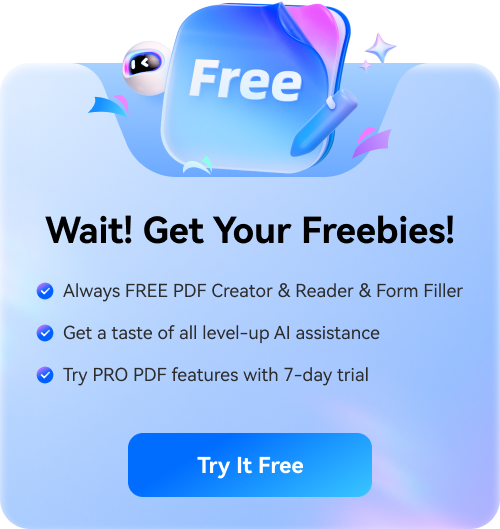In the realm of digital documents, the Portable Document Format (PDF) stands out for its adaptability and reliability, becoming the go-to format for sharing and viewing documents across various platforms and devices. However, there's a hidden gem often overshadowed by PDFs: the Forms Data Format (FDF file). While PDFs excel at presenting static content, FDF files elevate document interactivity. They're tailored to manage form data and annotations independently from the main PDF document.
In this article, we'll delve into FDF files, exploring their advantages and how they enhance document functionality. Additionally, we'll discuss how tools like Wondershare PDFelement facilitate easy access and manipulation of FDF files, empowering users to maximize their document management efficiency.
In this article
What Is FDF? Is It PDF’s Little Brother?
FDF, or Forms Data Format, is indeed closely related to PDF but serves a distinct purpose. FDF files are used to store form data and annotations separately from the main PDF document. Each letter in FDF symbolizes its function: "Forms" as in interactive form data, and "Data" describes the content within these forms. Essentially, FDF acts as a bridge between form data and the PDF document itself.
The history of FDF traces back to the development of PDF technology. Introduced by Adobe Systems, FDF was designed to manage form data independently, allowing for efficient data processing and management. Over time, FDF has evolved to support complex form interactions, annotations, and other interactive elements within PDF documents.
FDF is not a diminutive version of PDF but rather a complementary format that extends PDF's capabilities. While PDF encapsulates the document's visual representation, FDF handles the underlying data associated with forms and annotations, making it an indispensable tool for dynamic document management.
What Can FDF Do? Why Do I Need It?
The versatility of FDF shines through in various practical scenarios, enhancing user workflows and document management processes. Here are several compelling use cases and features of FDF:
- Data Extraction and Submission: FDF files are instrumental in extracting and submitting form data. Users can fill out interactive PDF forms, and FDF captures and transfers this data separately, allowing for streamlined data processing and integration with other systems.
- Annotations and Comments: FDF enables the storage of annotations and comments independent of the main PDF document. This feature is invaluable for collaborative workflows, where multiple users can contribute feedback and annotations without altering the original document.
- Customizable Forms: FDF facilitates the creation of customizable form templates. Users can pre-fill form fields, personalize templates, and generate FDF files that contain specific data, ensuring efficient form processing and customization.
- Integration and Automation: FDF seamlessly integrates with PDF editing tools like PDFelement, allowing users to leverage advanced features for form handling and data management. PDFelement's support for FDF empowers users to automate form-filling, extraction, and submission processes.
Regularly update PDF software to leverage the latest features and compatibility with FDF specifications.
When working with FDF files, ensure compatibility with PDF editing tools like PDFelement for seamless integration and enhanced functionality.
FDF can be utilized for efficient data capture and form processing in industries such as finance, healthcare, legal, and education.
How Do I Open an FDF File?
To open an FDF (Forms Data Format) file, you can use various software applications that support this format. Below, I'll guide you through the process of opening an FDF file using PDFelement and Adobe Acrobat DC on a Windows operating system.
Opening FDF Files on Windows Using PDFelement
PDFelement is a comprehensive PDF editing and management tool that supports FDF files for form data extraction and interaction. Follow these steps to open an FDF file in PDFelement:
- Start by opening PDFelement on your device.

- Click on "Open PDF" from the main interface and navigate to the location where your document file is saved. You can also drag-and-drop the document file

- After opening your PDF form, navigate to “Form” > “More” > “Import Data” and select the FDF file you want to upload to your document.

- Once the FDF file is opened, PDFelement will automatically load the necessary data into your PDF.

Features of PDFelement
- Edit PDF text, images, and links.
- Fill and create interactive forms.
- Convert PDFs to other formats like Word, Excel, or HTML.
- Annotate and comment on PDF documents.
- Secure PDFs with passwords and permissions.
Open an FDF File Using Adobe Acrobat DC
Adobe Acrobat DC is a popular PDF viewer and editor that also supports FDF files for form data handling. Follow these steps to open an FDF file in Adobe Acrobat DC:
- Launch the Adobe Acrobat application on your local device.

- Navigate to the "Menu" and select "Open." Choose the PDF document where you want to upload your FDF file.

- Locate the "Prepare a Form" feature under "All Tools."

- In the kebab menu, select “Import Data.” In the new pop-up window, select and open your FDF file.

- Adobe Acrobat will automatically populate the PDF file with the contents of the FDF document.
Features of Adobe Acrobat DC:
- View, create, and edit PDF files.
- Fill and sign PDF forms.
- Convert PDFs to various formats.
- Collaborate and share PDFs securely.
- Apply security features like passwords and permissions.
Conclusion
In conclusion, understanding the role of FDF (Forms Data Format) alongside PDF in document management is crucial for optimizing workflows. FDF files enhance PDF interactivity by efficiently handling form data and annotations. With tools like PDFelement, users can seamlessly convert, create, and interact with both PDF and FDF files, ensuring streamlined document processing and collaboration. Leveraging FDF's capabilities allows for dynamic data transfer, efficient archiving, and enhanced form management. Embracing FDF within document workflows empowers users to maximize efficiency and productivity while maintaining data integrity and accessibility across diverse platforms.

 G2 Rating: 4.5/5 |
G2 Rating: 4.5/5 |  100% Secure
100% Secure



